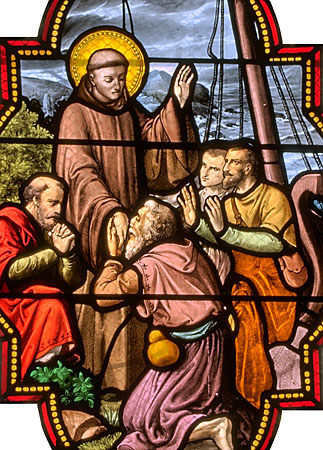 |
 |
|||
|
|
St. Brioc was the son of Cerpus, a nobleman
from Ceredigion, and his wife, Eldruda. His parents originally named him
Briafael but, on the advice of an angel, he took on the pet-name of Brioc
instead. Before he was ten, Brioc was sent to Paris to be educated by
Germanus, in the company of both SS. Patrick and Illtud.
Brioc was eventually ordained a priest, but by the age of twenty-five, he
felt it was time to return home to Wales. In Ceredigion, he set about the task of
converting the locals to Christianity from a monastic centre which he
established at Llandyfriog. But, not long after his arrival, he was
persuaded, by another angelic visitor, to sail away to Italy with 168
followers. The journey was rough and not helped by their boat being
attacked by an enormous sea-creature. Eventually the travellers landed in
Cornwall - possibly at Padstow Harbour near St.Breock - where they
encountered a pagan king named Conan.
Brioc soon converted the monarch and the rest of the Royal Court, before
pressing on into Europe. He crossed the Channel to Brittany and landed at
Le Conquest in Plouguerneau (Finistère). From here, the companions moved
down the River Jaudy and founded a monastery at Tréguier. However,
hearing of a pestilence ravaging his Wales, Brioc decided he must return
home. He left his new church in the hands of his 'nephew', Tudgual,
and delivered his people from their plague by advising the people to
confess their sins. Returning once more to Brittany, Brioc
decided to try his luck in new territories. With eighty-four companions,
he travelled to the mouth of the River Gouet. The local king, Riwal,
was not happy with these strangers arriving in his Kingdom but, upon
meeting them, realized that their leader, Brioc, was his own cousin. The
king gave Brioc his home, the 'Hall of the Champ du Rouvre' and
removed the Royal court to nearby Licelion in Hillion parish. The saint
was obliged to visit King Childebert of the Franks in Paris in order to
confirm this grant, and he travelled with St.
Samson and other bishops. Slowly, Brioc's men built a monastic
complex around their new hall and this become the great monastery of St.
Brieuc. St. Brioc died on 1st May, but it is
difficult to say exactly when. St. German of Paris was bishop there
between AD 555 & 576. St.Germanus of Auxerre died in AD 448. Conan
Meriadog was King of Dumnonia (including Cornwall) in the mid-4th century.
St. Tudwal lived in the mid-6th century. Riwal was King of Domnonée (in
Brittany) in the early 6th century. St. Patrick lived in the late 5th
century. St. Illtud lived in the early 6th century. St. Samson lived in
the mid-6th century. King Childebert ruled from AD 511 to 558. A lifetime
covering the early to mid-6th century seems likely for Brioc. Like King
Riwal, St. Tugdual appears to have been St. Brioc's cousin, rather than
his nephew, since he was actually Riwal's maternal nephew. The family
relationships would indicate that Brioc's mother, Eldruda, was a Princess
of the Royal House of Domnonée.
Records of St. Brioc date back to the 9th century. He could well be historic.
|
|||
| © Nash Ford Publishing 2001. All Rights Reserved. | ||||





 St. Brioc
St. Brioc